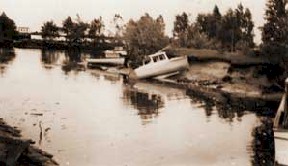
The Mining Journal
Marquette, MI
January 14, 2005
Incredible lake rise perplexed oldtimers

PHOTO: Stranded boats at "low tide" on the Dead River on June 16, 1939. (Marquette County Historical Museum photo.
By JENNIFER LAMMI, Marquette County History Museum
On Friday, June 16, 1939, shortly after 10:30 a.m., Lake Superior's water level at Marquette Harbor began to rise, pulling docks off their pilings and inundating the shoreline.
The surge reversed the flow of creeks, inundated wetlands, and flooded highways. Pilings in the lower harbor of Marquette, normally four feet above water, were submerged. Boats were washed onto shore. When the surge pulled away, boats had to be pushed back into the water to prevent them from becoming stranded as the water level dropped. Every half hour for the rest of the afternoon the surge alternately rose and fell. It continued into Saturday.
On the north side of Lake Superior, Canadian reports indicated that the surge reached an amplitude of eight feet in a period of 20 minutes at Heron Bay. In Munising, the surge was seven feet, two inches at the municipal dock. Logs that had been resting on the bottom of the bay for 20 years rose to the surface. Highway 41 between L'Anse and Baraga was closed due to the debris, including huge logs, which had washed up onto the highway as the waves surged over it.
At the time, it was unclear what could cause such a "tidal wave" that would leave life-long fishermen in awe. It was concluded that this was an outstanding example of a seiche.
Seiche (pronounced "saysh") is a French word that means "to sway back and forth." It was first used by a Swiss lake scientist, Francois-Alphonse Forel, in the late 1800s to describe the phenomenon when wind or air pressure changes cause the entire surface of a body of water to rhythmically rock back and forth from shore to shore like the swishing water in a bathtub. It is a resonant oscillation - a standing wave - in an enclosed body of water. Francois-Alphonse Forel is also known as the founder of limnology, or the study of lakes.
So what caused the tremendous seiche on Friday, June 16, 1939? Scientists determined that when a low pressure front moved across the countryside and reached the lake, it raised the pressure on the water causing it to depress the lake level and push the water away from the shore. After the low front passed and the pressure on the lake returned to more normal levels, the water rushed back in order to create equilibrium, causing the shoreline to be overcome with water. This oscillation occurred again and again, as the low pressure fronts passed. Although the fronts were not regular, the surges were. The highest waves occurred between 10 and 11:00 a.m. on Friday.
Earlier that day, Covington and Trout Creek reported winds of 50 to 75 miles per hour around 9 a.m., which tore the roofs off houses, leveled a dozen barns and blew 75 to 100 trees down in the area, some of which were two feet in diameter. The falling trees took down telephone, telegraph and power lines. Windows in almost every house in Trout Creek were broken, and many sheds were demolished. Injuries were confined to a few cows.
Around 10 a.m. the barometer at the U.S. Weather Bureau changed 0.3 inches in 15 minutes, the most unstable the official in charge had even seen. A downpour of pea-sized hail and rain followed, then the level of the lake dropped quickly as the severe thunderstorm reached it. As the front passed, the surge came onto shore. Storms raged until 4:40 p.m. that day, but the seiche continued through Saturday. No one was injured, and only minor damage was reported to lakeside buildings and small boats.
Seiches occur almost continually in enclosed water bodies, although most are not noticed as boats and shorelines are not effected. They only occur during the "ice-free" season. Seiches are an important part of lake ecology. When winds move surface waters away from the shoreline, an upwelling occurs where deeper waters rise to replace the surface waters driven offshore, and nutrients are brought up from the bottom of the lake. In essence, the water column is shifted.
Seiches also flush surrounding wetlands with nutrients and oxygen, making them more biologically productive and healthy.
Lake Superior is 32,000 square miles in area. It holds three quadrillion gallons of water, which is a three with 15 zeros after it. It contains 10 percent of the world's fresh water, with a shoreline length of more than 1,800 miles. It is the largest freshwater lake in the world by surface area and second largest in volume, second only to Lake Baikal in Russia. Given Superior's tremendous amount of water, it takes a very severe storm front for large seiches to occur.
On July 13, 1995, another seiche occurred, although it was not as severe. The lake water went out and came back within 15 to 20 minutes, and the water levels changed three feet in that time.
Editor's note: Along The Way is written monthly by the staff of the Marquette County History Museum, located at 213 N. Front St., Marquette. Museum hours are 10 a.m. to 5 p.m. Monday through Friday and each third Thursday of the month until 9 p.m.